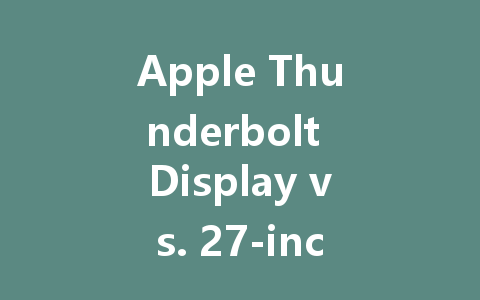
When it comes to choosing a display for your Mac, two models that frequently come up in discussions are the Apple Thunderbolt Display and the 27-inch Cinema Display. Both monitors have their unique features and appeal, but they cater to different needs and preferences. In this article, we will compare these two models across various factors, including design, performance, connectivity, and overall user experience to help you determine which is the right fit for you.
Design and Build Quality
Design plays a crucial role when selecting a monitor, especially for users who prioritize aesthetics alongside functionality.
Thunderbolt Display
The Apple Thunderbolt Display boasts a sleek and modern design that aligns perfectly with Apple’s aesthetic. Its aluminum body and glass panel provide a premium feel and durability. The edge-to-edge glossy glass screen enhances color vibrancy and sharpness, making it a favored choice among creative professionals.
Cinema Display
On the other hand, the 27-inch Cinema Display is also designed with elegance, featuring a similar aluminum construction. However, it has a slightly thicker bezel compared to the Thunderbolt Display. While still visually appealing, it lacks the modern touch of the Thunderbolt model.
Performance and Display Quality
When it comes to display quality, both monitors provide impressive experiences, but there are distinct differences.
Thunderbolt Display
The Thunderbolt Display features a resolution of 2560×1440 pixels (QHD), resulting in clearer visuals and more detailed images. Additionally, it excels in brightness levels, producing vivid colors that pop, making it ideal for photo and video editing.
Cinema Display
The Cinema Display, although an older model, offers the same resolution of 2560×1440 pixels. However, it lacks advanced technologies like the Thunderbolt Display. Users may find the color accuracy slightly less dynamic, especially under varying lighting conditions. This may be a consideration for those working in graphics-focused industries.
Connectivity Options
Connectivity is another pivotal aspect when choosing between these two displays.
Thunderbolt Display
The Thunderbolt Display takes the lead in connectivity, featuring a Thunderbolt port, which allows for fast data transfer speeds and has daisy-chaining capabilities. It also includes additional USB ports (three USB 2.0), FireWire 800, and an Ethernet port. This variety of options makes it highly flexible for users with multiple peripherals.
Cinema Display
The Cinema Display offers fewer connectivity options. It features USB 2.0 ports and a Mini DisplayPort connection. While it serves basic connectivity needs well, it does not match the versatility of the Thunderbolt Display. Users with several peripherals might find this limitation frustrating.
Audio and Built-in Features
In terms of audio and built-in features, the Thunderbolt Display includes built-in speakers and a FaceTime HD camera, facilitating video conferencing and media playback without needing extra devices.
The Cinema Display, while also equipped with built-in speakers, does not come with a FaceTime camera, which may be a downside for users who frequently engage in video calls.
Price Comparison
Price can be a deciding factor for many potential buyers. The Thunderbolt Display typically comes at a higher price point compared to the 27-inch Cinema Display. However, considering the advanced features, build quality, and improved connectivity options, many users find the investment in the Thunderbolt Display worthwhile.
Use Case Scenarios
Best for Creative Professionals
For those involved in design, photography, and video editing, the Apple Thunderbolt Display is undoubtedly the better choice due to its superior color accuracy, brightness, and enhanced connectivity options. Its modern features make it a solid investment for long-term use.
Best for Casual Users
On the flip side, if you’re a casual user who requires a display primarily for tasks like browsing, video streaming, and word processing, the 27-inch Cinema Display can be sufficient. Its quality is still impressive, and it can save you some money, especially if you manage to find a good deal on a second-hand unit.
Conclusion
Choosing between the Apple Thunderbolt Display and the 27-inch Cinema Display ultimately depends on your specific needs and budget. The Thunderbolt Display emerges as the winner for professionals seeking top-tier performance and connectivity. Conversely, the Cinema Display remains a strong contender for casual users looking for solid performance at a more affordable price point.
In summary, both displays have their unique strengths. Depending on your preferences, either model can enhance your productivity and provide an enjoyable viewing experience. Consider what features are most important to you, and you’ll be well on your way to making the best choice for your workspace.